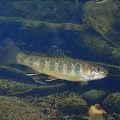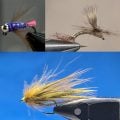Fly Tying: How to Tie a Mickey Finn
Producer: Tim Flagler
I can’t believe I’ve done more than 450 tying videos and am just now getting around to doing a Mickey Finn. But, as they say, better late than never.
For this fly, I’m going to take full advantage of my vise’s rotary function. It’s not absolutely essential, but does make producing the fly’s body much easier.
For a hook, I’m going to go with a Dai-Riki #700 in size 8, but any 4X long streamer hook will do. Begin by getting the hook firmly secured in the jaws of your tying vise and making sure it rotates correctly.
For thread, I’ve loaded a bobbin with a spool of black UTC 70 Denier. Get the thread started on the hook shank leaving an eye-length space behind the eye and take a few wraps rearward before snipping or breaking off the tag.
Medium-sized, oval, silver French tinsel is used for the rib, a 10 inch length will make numerous flies. Lay one end of the tinsel on top of the hook shank and start taking thread wraps to secure it. As you wrap rearward with your tying thread, allow the tinsel to be pushed first to the far side of the hook then to the underside. Giving your bobbin a good counterclockwise spin every so often will uncord and flatten the thread, and allow you to create a very thin, even underbody on the fly. Keep taking these thin, flat touching wraps all the way back to the start of the hook bend.
Then, do your best to push the tinsel that started on the top of the hook shank, all the way around to the underside of the shank. You can then use your vise’s rotary function to make touching wraps back up the hook shank. The idea is to produce the smoothest underbody possible. End with your tying thread at the initial tie-in point.
Medium-sized gold/silver mylar tinsel is used to create the body of the fly. Snip a good 7 inch length from the spool to make sure you have enough. Trim one end off at an angle and lay the tinsel against the near side of the hook with the silver side facing you. Take a few nice tight thread wraps to secure it.
If you have one, bring your bobbin cradle around into the correct position and use it to hold your tying thread in line with the hook shank. Get hold of the tinsel and start taking wraps rearward with it. Rarely does the first wrap look good, so don’t sweat it. Start rotating your vise to continue taking touching wraps with the tinsel rearward, down the hook shank. Make sure to cover up all the thread wraps at the hook bend then change the angle of the mylar to start wrapping forward.
Two-colored mylar like this has a tendency to separate when wrapping over a long length. Do your best to kind of flatten it out and keep wrapping. When you reach your tying thread, use it to anchor the mylar. Just like the first wrap, the last one usually doesn’t look great but will get covered up later. Once the mylar’s secured, you can snip the excess off close.
Super glue, or here Fly Tyer’s Z-Ment, applied sparingly to the thread wraps and mylar ends will help to ensure they don’t come unraveled. Think of it kind of like hitting the save button on your computer. End with your tying thread at the initial tie-in point.
If you need to, swing your bobbin cradle back into position and once again use it to hold your tying thread. This will allow you to pick up the oval tinsel, hold it at about a 45 degree angle to the hook shank, and simply rotate the vise. Doing it in this manner usually produces nice, evenly spaced wraps all the way up the shank to the tie-in point. There, you can retrieve your bobbin from the cradle and use wraps of tying thread to anchor the tinsel rib. When you’re done, snip the excess off close.
Once again it’s a good idea to reach for the super glue and apply just the smallest amount to save your work. Then take tight thread wraps rearward to about two eye-lengths behind the back edge of the hook eye.
Yellow bucktail is used to form the lower part of the fly’s wing. You really don’t need much at all. After snipping a small clump of hair free from the hide, strip out any short hairs from the butts and any excessively long hairs from the tips. The hairs are generally way too long for the fly so I like to snip an inch or so of the butt ends off, which makes stacking a bit easier. Feed that hair, tips first, into a stacker – one with a wide mouth works very well. Then give the bucktail a real good stacking. Once done, open the stacker and get hold of the hair tips with the fingers of your left hand then pass the clump to your right. Measure to form a wing that extends to the back edge of the hook bend then cord up your tying thread by spinning your bobbin clockwise. The corded thread will be stronger and bite into the somewhat slippery bucktail better than flattened thread. Once secured, lift the butt ends up and snip them off at a shallow angle. Take thread wraps forward over the snipped-off ends, down to the hook shank to the back edge of the hook eye. Take thread wraps rearward to where you took that first wrap around the bucktail. This will be the back edge of the head of the fly.
Now it’s time for a thin layer of red bucktail. Again, snip a sparse clump free from the hide, clean out the lower short hairs and longer tips then snip an inch or so of the butts off square. Place the clump tips first into your stacker, give it a good stacking then get hold of the hair tips as you did before. Place the red bucktail on top of the yellow so their tips are aligned then squeeze it in the fingers of your left hand as you take thread wraps to secure it. Just as you did with the yellow bucktail, snip the red off at a shallow angle and take thread wraps to lock it down.
The top part of the wing is also yellow bucktail. Snip a slightly larger clump free from the hide, clean out the lower short hairs and longer ones from the tips, trim the butt ends off square, stack to align the tips and complete the same tie-in and trim procedure as before.
Yes, your thread will likely want to jump off the little cliffs formed by the snipped-off bucktail. You can lessen this by gently angling the thread wraps and by building up a mini thread dam behind the hook eye. Be really sure to get all the underlying material covered up with the thread wraps, while at the same time trying to keep the head of the fly reasonably short and thin. When you’re happy with the look, pick up your whip finish tool and do a 5 or 6 turn, back to front whip finish, seat the knot well and snip or cut your tying thread free.
Rather than head cement, I prefer UV cure resin, here, Solarez Bone Dry. The stuff penetrates the thread wraps yet at the same time builds up a nice glossy head on the fly. With all the texture of the thread filled in and smooth, use your bodkin to make sure the eye is clear then give the entire head an ample bath of UV light. In just a matter of seconds, the resin will cure to a tack-free finish and your Mickey Finn is ready to fish.
The Mickey Finn is not as popular a pattern as it used to be but trust me on this one, it’s still a remarkably effective fly.
Fly Tying: How to Tie a Light Cahill Wet Fly
Fly Tying: How to Tie a Pinky Blinder Euro Nymph Soft Hackle











